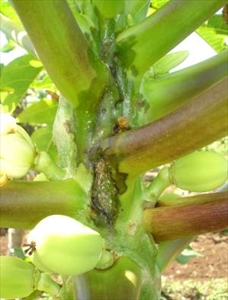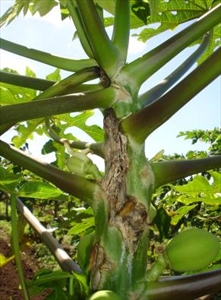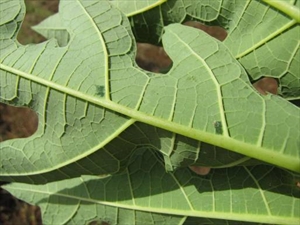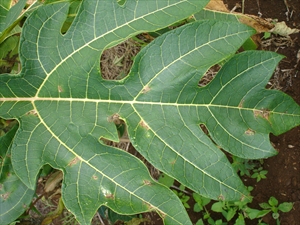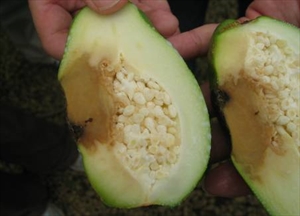Papaya bacterial crown rot, papaya bacterial decline, papaya bacterial stem canker
Pacific Pests, Pathogens, Weeds & Pesticides - Online edition
Pacific Pests, Pathogens, Weeds & Pesticides
Papaya crown rot (172)
Erwinia papayae
The disease has been reported from the Caribbean, present with limited distribution in South America (Venezuela), and present in Indonesia, Malaysia, the Philippines, in Southeast Asia. It is recorded in Northern Mariana Islands, Fiji, and Tonga.
Papaya; however, the bacterium has been recovered from the surface of leaves of cowpea, tomato and rockmelon and also from the weed, Chromolaena.
Dark green, 'water soaked' - as if water has been injected into the stems - spots and patches occur on the young tender stems, and spread rapidly, developing into foul-smelling wet rots which often join together forming large cankers (Photos 1-3). Rots in the crown kill the growing point, or the top of the stem falls off where the cankers develop (Photos 4&5). On the leaves, brown, angular patches of rot occur (Photos 6-8), and long oval spots occur on the petioles (the leaf stalks) causing them to break, and the leaves to wilt and die. On the fruit, water-soaked spots, which later become firm and sunken, may reach the seed cavity (Photo 9).
If dry times occur, infections on the leaves become brown patches which tear, giving the leaves a ragged look.
Spread occurs locally in wind-driven rain and over longer distances on seed. Spread by snails is a possibility. The bacterium does not survive for long in decaying stems and leaves, but can survive for long periods in stem cankers, and inside infected vascular tissues of the stem. It does not survive for more than 2 weeks in the soil.
In wet tropical locations, bacterial crown rot is considered one of the most important diseases of papaya (Photo 10). In the 1960s, the disease decimated papaya production in the West Indies, and more recently it has done considerable harm to some 800 ha of plantations in Malaysia. An outbreak occurred in Tonga in 2009 which was said to be highly destructive.
Look for water-soaked spots on the stems, spreading and developing into large foul-smelling rots causing the shoot to collapse or the top of the stem to fall off. Look for angular spreading water-soaked patches of rot on the leaves, and spots on the fruit which become sunken and firm, and may reach the seeds.
QUARANTINE
The outbreak in Tonga is said to have been associated with the introduction of varieties for evaluation, which suggests the bacterium can be seedborne. Countries need to ensure that imported seed is certified free from contamination by this bacterium, and grown under post-entry surveillance in closed quarantine. Authorities in Australia recommend a hot water treatment for seed of 50°C for 20 minutes.
CULTURAL CONTROL
Before planting:
- Treat seed with hot water as above if there is any chance that it is contaminated with Erwinia papayae.
After harvest:
- Bury any remains of the crop in the soil within the plantation. The bacterium remains alive for only 2 weeks in the soil.
RESISTANT VARIETIES
Papaya varieties differ in tolerance to bacterial crown rot. In the Philippines, selections from among the Philpack Solo canning variety showed resistance; in the Northern Mariana Islands resistance has been found in tests with varieties Saipan Red, Dwarf Solo No. 7355, Waimanolo Solo, and among local varieties; and, in Guadeloupe, crosses between local and Solo varieties showed tolerance.
CHEMICAL CONTROL
Copper sprays have not been effective in the Caribbean, but copper hydroxide is used in the Philippines.
____________________
When using a pesticide, always wear protective clothing and follow the instructions on the product label, such as dosage, timing of application, and pre-harvest interval. Recommendations will vary with the crop and system of cultivation. Expert advice on the most appropriate pesticide to use should always be sought from local agricultural authorities.
AUTHOR Grahame Jackson
Information (and Photos 1-10) from Threat specific contingency plan: Bacterial crown rot, Erwinia papayae (2011). (https://www.planthealthaustralia.com.au/wp-content/uploads/2013/03/Bacterial-crown-rot-CP.pdf). Plant Health Australia; and Fullerton RA et al. (2011) First record of bacterial crown rot of papaya (Carica papaya) caused by an Erwinia papayae-like bacterium in the Kingdom of Tonga. Plant Disease 95: 70; and from Plant Health Australia (undated) Bacterial crown rot. (https://www.planthealthaustralia.com.au/wp-content/uploads/2018/02/Bacterial-crown-rot-FS.pdf).
Produced with support from the Australian Centre for International Agricultural Research under project PC/2010/090: Strengthening integrated crop management research in the Pacific Islands in support of sustainable intensification of high-value crop production, implemented by the University of Queensland and the Secretariat of the Pacific Community.

